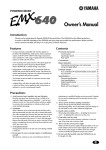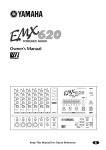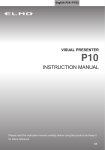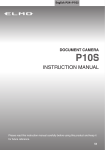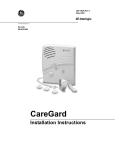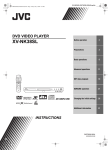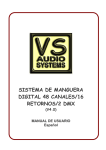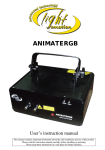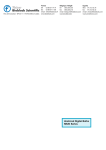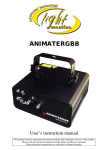Download Yamaha EMX860ST Owner`s manual
Transcript
Owner’s Manual SEE REAR PANEL CAUTION. 1 2 HIGH 3 HIGH 4 HIGH 5 6 HIGH HIGH 7 HIGH 8 HIGH POWER HIGH VOCAL –15 +15 MID –15 +15 MID –15 +15 LOW –15 +15 MID –15 +15 LOW –15 +15 –15 +15 LOW –15 +15 MID MID –15 +15 –15 +15 LOW LOW –15 +15 MID –15 +15 MID –15 +15 LOW –15 +15 L HALL MID –15 +15 LOW –15 +15 S HALL +6 +3 0 –5 –10 –12 • 6 • 0 • 6 • +12 –12 • 6 • 0 • 6 • +12 125 250 500 1k 2k 4k PHANTOM +48V ON OFF 8k LOW LIMITER –15 +15 MONI –15 +15 MONI 0 10 EFFECT 0 10 EFFECT 0 10 PAN L R +15 0 10 0 10 L R +15 0 10 0 10 L R +15 0 10 0 10 L R +15 0 10 0 10 L R +15 0 0 10 10 L 0 R +15 0 10 EFFECT RTN 0 10 0 10 MONI MASTER DIGITAL EFFECT MONITOR EFFECT 10 BAL/PAN LEVEL –15 MONI EFFECT PAN LEVEL –15 MONI EFFECT PAN LEVEL –15 MONI EFFECT PAN LEVEL –15 MONI EFFECT PAN LEVEL –15 MONI EFFECT PAN LEVEL –15 MONI ON L 0 –12 • 6 • 0 • 6 • +12 10 BAL/PAN R LEVEL L –12 • 6 • 0 • 6 • +12 125 R 250 500 1k 2k 4k 8k +6 +3 0 –5 –10 L MAIN L R R LIMITER LEVEL L+R BRIDGE 0 10 PAD 0 10 PAD 0 10 PAD 0 10 0 10 PAD PAD 0 10 0 10 0 10 PAD 0 10 EFFECT OUT 1 2 3 4 5 6 Hi-Z Hi-Z Hi-Z Hi-Z Hi-Z Hi-Z Lo-Z Lo-Z Lo-Z Lo-Z Lo-Z Lo-Z 7 L LINE R (MONO) MIC 8 EFFECT L LINE R EFFECT OUT (MONO) MIC FOOT SW 0 10 EFFECT RTN 0 10 AUX IN 0 10 TAPE IN 0 10 AUX IN L (MONO) R STEREO MASTER POWER AMP MAIN STEREO POWERED MIXER L L MAIN(STEREO) MONITOR L R R R INPUT TO MAIN TAPE REC IN OUT OUTPUT E FCC INFORMATION (U.S.A.) 1. IMPORTANT NOTICE: DO NOT MODIFY THIS UNIT! This product, when installed as indicated in the instructions contained in this manual, meets FCC requirements. Modifications not expressly approved by Yamaha may void your authority, granted by the FCC, to use the product. 2. IMPORTANT: When connecting this product to accessories and/or another product use only high quality shielded cables. Cable/s supplied with this product MUST be used. Follow all installation instructions. Failure to follow instructions could void your FCC authorization to use this product in the USA. 3. NOTE: This product has been tested and found to comply with the requirements listed in FCC Regulations, Part 15 for Class “B” digital devices. Compliance with these requirements provides a reasonable level of assurance that your use of this product in a residential environment will not result in harmful interference with other electronic devices. This equipment generates/uses radio frequencies and, if not installed and used according to the instructions found in the users manual, may cause interference harmful to the operation of other electronic devices. Compliance with FCC regulations does not guarantee that interference will not occur in all installations. If this product is found to be the source of interference, which can be determined by turning the unit “OFF” and “ON”, please try to eliminate the problem by using one of the following measures: Relocate either this product or the device that is being affected by the interference. Utilize power outlets that are on different branch (circuit breaker or fuse) circuits or install AC line filter/s. In the case of radio or TV interference, relocate/reorient the antenna. If the antenna lead-in is 300 ohm ribbon lead, change the lead-in to coaxial type cable. If these corrective measures do not produce satisfactory results, please contact the local retailer authorized to distribute this type of product. If you can not locate the appropriate retailer, please contact Yamaha Corporation of America, Electronic Service Division, 6600 Orangethorpe Ave, Buena Park, CA 90620 This applies only to products distributed by YAMAHA CORPORATION OF AMERICA. WARNING: THIS APPARATUS MUST BE EARTHED IMPORTANT THE WIRES IN THIS MAINS LEAD ARE COLOURED IN ACCORDANCE WITH THE FOLLOWING CODE: GREEN-AND-YELLOW : EARTH BLUE : NEUTRAL BROWN : LIVE As the colours of the wires in the mains lead of this apparatus may not correspond with the coloured markings identifying the terminals in your plug, proceed as follows: The wire which is coloured GREEN and YELLOW must be connected to the terminal in the plug which is marked by the letter E or by the safety earth symbol or coloured GREEN and YELLOW. The wire which is coloured BLUE must be connected to the terminal which is marked with the letter N or coloured BLACK. The wire which is coloured BROWN must be connected to the terminal which is marked with the letter L or coloured RED. * This applies only to products distributed by YAMAHA KEMBLE MUSIC (U.K.) LTD. Important 3 Important Read the Following Before operating the EMX860ST Warnings • Do not allow water to enter this unit or allow the unit to become wet. Fire or electrical shock may result. • Connect this unit’s power cord only to an AC outlet of the type stated in this Owner's Manual or as marked on the unit. Failure to do so is a fire and electrical shock hazard. • Do not scratch, bend, twist, pull, or heat the power cord. A damaged power cord is a fire and electrical shock hazard. • Do not place heavy objects, including this unit, on top of the power cord. A damaged power cord is a fire and electrical shock hazard. In particular, be careful not to place heavy objects on a power cord covered by a carpet. • If you notice any abnormality, such as smoke, odor, or noise, or if a foreign object or liquid gets inside the unit, turn it off immediately. Remove the power cord from the AC outlet. Consult your dealer for repair. Using the unit in this condition is a fire and electrical shock hazard. • Should this unit be dropped or the cabinet be damaged, turn the power switch off, remove the power plug from the AC outlet, and contact your dealer. If you continue using the unit without heeding this instruction, fire or electrical shock may result. • If the power cord is damaged (i.e., cut or a bare wire is exposed), ask your dealer for a replacement. Using the unit with a damaged power cord is a fire and electrical shock hazard. • Do not remove the unit's cover. You could receive an electrical shock. If you think internal inspection, maintenance, or repair is necessary, contact your dealer. • Do not modify the unit. Doing so is a fire and electrical shock hazard. Cautions • Allow enough free space around the unit for normal ventilation. This should be: 20 cm at the sides, 40 cm behind, and 40 cm above. These distances should also be adopted when rack-mounting the unit. For normal ventilation during use, remove the rear of the rack or open a ventilation hole. If the airflow is not adequate, the unit will heat up inside and may cause a fire. • This unit has ventilation holes at the front, rear and sides to prevent the internal temperature rising too high. Do not block them. Blocked ventilation holes are a fire hazard. • Clean the contacts of the phone plug before connecting it to the SPEAKERS jack of this unit. Dirty contacts may generate heat. • Use only speaker cables when connecting speakers to amplifier outputs. Using other types of cables is a fire hazard. • Hold the power cord plug when disconnecting it from an AC outlet. Never pull the cord. A damaged power cord is a potential fire and electrical shock hazard. • Do not touch the power plug with wet hands. Doing so is a potential electrical shock hazard. EMX860ST—Owner’s Manual 4 Important Operating Notes • The digital circuits of this unit may induce a slight noise into nearby radios and TVs. If noise occurs, relocate the affected equipment. • Using a mobile telephone near this unit may induce noise. If noise occurs, use the telephone away from the unit. • XLR-type connectors are wired as follows: pin 1: ground, pin 2: hot (+), and pin 3: cold (–). • Do not set all equalizer controls and faders to maximum. Doing so may cause oscillation depending on the condition of the connected unit and speakers, and may damage the speakers. • The performance of components with moving contacts, such switches, rotary controls, faders, and connectors, deteriorates over time. The rate of deterioration depends on the operating environment and is unavoidable. Consult your dealer about replacing defective components. EMX860ST—Owner’s Manual Introduction 5 Introduction Thank you for purchasing the Yamaha EMX860ST Powered Mixer. The EMX860ST has the following features. In order to take full advantage of the EMX860ST and enjoy long and trouble-free performance, please read this owner’s manual carefully, and keep it in a safe place for future reference. Features Contents • The EMX860ST features eight input channels that support a wide range of audio sources, from microphones to line-level devices. The microphone input for each channel has a +48 V phantom powering for use with condenser-type microphones. Front and rear panel ................................ 6 • A built-in independent monitoring power amplifier rated at 200 W, in addition to two powerful main power amplifiers (200 W + 200 W — total 400 W monaural in bridge connection), is capable of driving stereo main speakers and monitoring speakers on stage simultaneously in a sophisticated PA system environment. Basic Operation....................................... 15 • Individual seven-band graphic equalizers are provided to the main and the monitor sections. In this way, you can individually adjust the volume level and frequency response of the main speakers and monitor speakers. • Two limiter circuits are built-in to prevent excessive input levels to the amp. • A digital effect with three selectable effect types is built-in. A variety of effects can be applied to add reverberation or ambiance to vocals or instrumental sounds. Control panel ............................................ 6 Input/output panel................................... 10 Rear panel ................................................ 12 Connections............................................ 13 Connecting microphones and instruments ........................................... 15 Sending an independent mix to the monitor speakers ......................... 15 Using the digital effect ............................. 15 Example setups ....................................... 16 As a conference PA system/ installed sound system........................... 16 As a band PA ............................................ 18 Troubleshooting...................................... 20 Specifications .......................................... 21 General specifications............................... 21 Input specifications .................................. 22 Output specifications ............................... 22 Dimensions .............................................. 23 Block and Level diagram........................... 23 EMX860ST—Owner’s Manual 6 Front and rear panel Front and rear panel Control panel ■ Channel section Use these controls to adjust factors such as the equalization, (frequency response), volume, effect and monitor output level for the input signal to each channel. 1 HIGH –15 +15 MID 2 Monitor controls (MONI) For each channel, this controls the amount of signal that is sent to the MONI bus. The signal of the MONI bus is sent to the speakers connected to the MONITOR A/B jacks and to the MONITOR jacks (input/output panel 6). Note: The signal is sent to the MONITOR bus from a location before the level control (5) of each channel. This means that it will not be affected by the setting of the LEVEL control. 1 –15 +15 LOW –15 +15 MONI 2 0 10 EFFECT 3 0 10 PAN 4 L R LEVEL 5 0 10 PAD 6 1 1 Equalizer controls (HIGH, MID, LOW) This is a 3-band equalizer that adjusts the high frequency range, mid frequency range, and low frequency range of each channel. Response is flat when the knobs are in the ▼ position. Rotating it toward the right will boost the corresponding frequency band, and rotating it toward the left will cut it. The base frequency (or center frequency), range of boost or cut, and equalizer type of each band are as follows. HIGH: 10 kHz ±15 dB shelving type MID: 2.5 kHz ±15 dB peaking type LOW: 100 Hz ±15 dB shelving type EMX860ST—Owner’s Manual 3 Effect control (EFFECT) For each channel, this controls the amount of signal that is sent to the EFFECT bus. The signal of the EFFECT bus passes through the EFFECT section and the built-in digital effect, and is sent to the external effect device connected to the EFFECT OUT jacks (input/output panel 3). Note: The signal is sent to the EFFECT bus from a location after the level control (5) of each channel. This means that the amount of signal that is sent to the EFFECT bus will be affected not only by the setting of the effect control, but also by the setting of the level control. 4 PAN control (BAL/PAN control for CH7/8) This knob adjusts the stereo image (L/R) for each channel. Adjust for equal volume on left and right with a sound source input to the CH7 and 8 LINE connectors (L/R). 5 Level control (LEVEL) This adjusts the output level for each channel. 6 Pad switch (PAD) (1–6 only) This switch attenuates the input signal by 30 dB. When connecting a line level device to channels 1–6, or if the mic input is distorted, turn this switch on (the pressed-in position). Control panel ■ DIGITAL EFFECT section This section allows you to turn the built-in digital effect on/off and to select the effect type. ■ EFFECT section This section allows you to adjust the level of the signal sent from the EFFECT bus to an external effect device. 9 VOCAL L HALL 7 7 0 10 EFFECT OUT EFFECT S HALL ON 8 DIGITAL EFFECT 7 Effect select switch 9 EFFECT OUT control This adjusts the effect send level for an external effect device connected to the EFFECT OUT jack (input/output panel 3). Note: The EFFECT OUT control does not affect the level sent to the built-in digital effect. Select the effect type for the built-in digital effect. 8 DIGITAL EFFECT ON switch Use this switch to turn the digital effect on and off. When this switch is on, the effect bus signal processed with the built-in digital effect is sent to the ST bus and MONI bus. The mix level of the effect sound is adjusted with the EFFECT RTN control in the MAIN and MONITOR sectins. EMX860ST—Owner’s Manual 8 Front and rear panel ■ MONITOR section ■ MAIN section This section allows you to adjust the tone and volume of the MONITOR bus, and specify the mix level of the built-in digital effect. This section allows you to adjust the tone and volume of the ST bus, the mix level of the built-in effect, and the mix level of the external input. D 0 –12 • 6 • 0 • 6 • +12 +6 +3 0 –5 –10 –12 • 6 • 0 • 6 • +12 125 250 500 1k 2k 4k C –12 • 6 • 0 • 6 • +12 –12 • 6 • 0 • 6 • +12 125 250 500 1k 2k 4k +6 +3 0 –5 –10 8k L 10 0 I R 8k A B 0 10 EFFECT RTN 0 H 10 MASTER MONITOR 0 10 EFFECT RTN 0 10 AUX IN 0 TAPE IN 10 MASTER MAIN STEREO 0 Graphic equalizer The EMX860ST has a 7-band graphic equalizer for adjusting the frequency response of the MONI bus signal. This allows you to cut or boost each frequency band by a maximum of ± 12dB. You can use these sliders to reduce the level of frequency bands at which feedback easily occurs. Frequency response is flat when a slider is in the center position. Moving a slider in the positive direction will boost, and in the negative direction will cut. These graphic equalizer settings affect both the MONI bus signal output to the speakers and the line level signal sent from MONITOR jack signal (input/output panel 6). A EFFECT RTN control This control adjusts the effect signal level sent to the MONI bus from the built-in digital effect. B MASTER control This control adjusts the MONI bus signal output level. This setting is output to both the front and rear panel MONITOR jacks and appears in the MONI bus signal. C Peak level indicator This indicator allows you to monitor the level of the signal which is output from the MONITOR jack (input/output panel 6). Note: To avoid distortion, adjust the MASTER control (B) so that the 0 indicator lights occasionally. EMX860ST—Owner’s Manual E F G D Graphic equalizer The EMX860ST has a 7-band graphic equalizer for adjusting the frequency response of the ST bus signal. This allows you to cut or boost each frequency band by a maximum of ±12dB. These graphic equalizer settings affect both the ST bus signal output to the speakers and the line level signal output from the MAIN (STEREO) jack (input/output panel 6). E EFFECT RTN control Use this control to adjust the effect signal sent to the ST bus from the built-in digital effect. F AUX IN control This adjusts the amount of signal that is sent from the AUX IN jack to the ST bus. G TAPE IN This adjusts the amount of signal that is sent from the TAPE IN jacks to the ST bus. H MASTER control This control adjusts the ST bus signal output level. This setting is output to the SPEAKERS L/ R/L+R, BRIDGE jacks and the MAIN (STEREO) jack on the rear panel and appears in the ST bus signal. I Peak level indicator This indicator allows you to monitor the level of the signal which is output from the MAIN (STEREO) jack (input/output panel 6). Note: To avoid distortion, adjust the MASTER control (H) so that the 0 indicator lights occasionally. Control panel ■ POWER AMP section This section allows you to select the signals that will be output from the built-in three-channel power amplifier, and to select the BRIDGE mode. 9 ■ POWER indicator & PHANTOM switch L LIMITER POWER PHANTOM +48V ON OFF MONI M MAIN L J R L POWER indicator This indicator will light when the power of the EMX860ST is turned on. LIMITER L+R BRIDGE M PHANTOM +48 V switch K STEREO POWER AMP This switch turns the phantom power supply on/ off for the Lo-Z input jacks of channels 1–6 and MIC input jacks of channels 7–8. J LIMITER indicator This indicator lights up when the level of the signal output from the power amp section reaches the maximum and the limiter is activated. Adjust appropriate control so that the indicator lights up for only a short while when the signal reaches the maximum level. Note: The indicator lights up or flashes for a longer duration if the power amp section is significantly overloaded, which could result in malfunction. Avoid such a situation. K Stereo/Bridge select switch Select a signal route depending on the speakers connected to the SPEAKERS L/R/L+R BRIDGE jacks 2 on the rear panel. • L+R BRIDGE The monaural signal mixed in the L and R channels of the ST bus is output to the SPEAKERS L+R BRIDGE jack. However, the ST bus signal output from MAIN (STEREO) jack is still a stereo signal. A bridge connection is then made between the stereo power amps (200 W+200 W) to use them as a 400 W monaural power amp. • STEREO MAIN bus signals are output from the POWERAMP 1 A/B and POWER AMP 2 A/B jacks. Only the MASTER control H is effective. EMX860ST—Owner’s Manual 10 Front and rear panel Input/output panel L LINE R L LINE R Hi-Z Hi-Z Hi-Z Hi-Z Hi-Z Hi-Z Lo-Z Lo-Z Lo-Z Lo-Z Lo-Z Lo-Z (MONO) (MONO) EFFECT OUT MIC MIC AUX IN FOOT SW L (MONO) R POWERED MIXER L L MAIN(STEREO) MONITOR R L R R INPUT TO MAIN TAPE REC IN OUT 1 2 1 Channel input jacks (Hi-Z, Lo-Z) 1–6 These are the input jacks for channels 1–6. By using the PAD switches (control panel 6) you can connect any of the jacks to a wide range of sources from mics to line level devices (synthesizers or rhythm boxes etc.). The Lo-Z jacks can provide +48 V phantom power, allowing you to use condenser microphones. Both Hi-Z and Lo-Z are balanced, and are compatible with microphones of output impedance 50–600Ω or line level devices of 600Ω. The nominal input level is from –40 dB to –10 dB for the Hi-Z jacks, and from –50 dB to –20 dB for the Lo-Z jacks. Pin connections for the Hi-Z and Lo-Z jacks are as follows. Lo-Z jacks (XLR type) Hi-Z jacks (TRS phone jacks) Pin 1: ground Sleeve: ground Pin 2: hot (+) Tip: hot (+) Pin 3: cold (–) Ring: cold (–) S + - GND R T GND - + Note: It is not possible to simultaneously use both the Hi-Z and Lo-Z inputs of a given channel. For each channel, use only one of the inputs as appropriate for the input source. Phantom power is switched on/off in simultaneously for channels 1–8. For this reason, devices which do not require phantom power must be connected to the Hi-Z or LINE jacks if the PHANTOM +48 V switch (control panel M) is on. EMX860ST—Owner’s Manual 34 5 OUTPUT 6 2 Channel input jacks (MIC/LINE) 7–8 These are the input jacks for channels 7–8. Connect microphones to the MIC jacks. Connect line-level devices, such as synthesizers to LINE L (MONO)/R jacks if the devices are stereo sound sources. Use the LINE L (MONO) jack if the devices are monaural sound sources. The MIC jacks are balanced, and are compatible with microphones of output impedance 50– 600Ω. The LINE jacks are unbalanced, and are compatible with line level devices of 600Ω output impedance. Nominal input level is –50 dB for the MIC jacks and –20 dB for the LINE jacks. Note: The MIC and LINE inputs for channel 7 can be used simultaneously but their levels cannot be adjusted separately (Same for channel 8.) 3 Effect output jack (EFFECT OUT) The input of an external effect such as a delay or echo can be connected to this jack. The signal adjusted by the EFFECT control of each channel will be sent to the EFFECT bus, its level adjusted by the EFFECT OUT control, and output from this jack. The nominal output level and impedance are +4 dB/10 kΩ. 4 Foot switch jack (FOOT SW) You can connect a Yamaha FC5 foot switch (sold separately) to this jack and use it to turn the built-in digital effect on and off. The Digital Effect ON switch on the front panel must always be set to ON in order to use the foot switch. Input/output panel 11 5 AUX IN/TAPE IN jacks These are input jacks that allow the signal from an external device to be added to the MAIN output. • AUX IN jacks: Connect these jacks to the output jacks of an external effects processor. If the effects processor has a stereo output, connect it to the AUX IN L (MONO) and R jacks. If it has monaural output, use the AUX IN L (MONO) jack. Signal input to these jacks is sent to the ST bus. • TAPE IN jacks: Use these jacks to connect a stereo device, such as a cassette player or a CD player. The signals input to these jacks is sent to the ST bus. The nominal input level and impedance are –10 dB/ 600Ω for the AUX IN jack, and –10 dBV/600Ω for the TAPE IN jacks. 6 REC OUT/MONITOR/MAIN (STEREO) jacks These are output jacks which send line level signals from the EMX860ST to external devices. A stereo recording device such as a cassette recorder or MD recorder can be connected to the REC OUT jacks, and a playback device such a power amp can be connected to the MONITOR and MAIN (STEREO) jacks. The signals sent from each jack are as follows. • REC OUT jacks: The ST bus signal before it has passed through the MASTER control and graphic equalizer • MONITOR jack: The MONI bus signal which has passed through the Monitor MASTER control and graphic equalizer • MAIN (STEREO) jack: The ST bus signal which has passed through the Main MASTER control and graphic equalizer The nominal output level and impedance are –10 dBV/10 kΩ for the REC OUT jacks, and +4 dB/10 kΩ for the MONITOR/MAIN (STEREO) jacks. EMX860ST—Owner’s Manual 12 Front and rear panel Rear panel SPEAKERS B L+R BRIDGE R MONITOR A B 1 A L B A 2 POWER 3 ON/ OFF 1 SPEAKERS MONITOR jacks Connect monitoring speakers to these jacks. MONI bus signals adjusted at the MONITOR section are output from these jacks. The SPEAKERS MONITOR A and B jacks are internally connected in parallel, and output the same signals. You can connect speakers with an impedance of 4–8Ω to either or both the A or B jacks. You can connect speakers with an impedance of 8–16Ω to both pairs. Note: Do not connect any devices other than speakers to these jacks. Do not confuse these jacks with the MONITOR jacks on the I/O panel. 2 SPEAKERS L/R/L+R BRIDGE jacks Use these jacks to connect the main speakers. These jacks output ST bus signals that are adjusted at the MASTER section. The speaker connection varies depending on the setting of the stereo/bridge select switch. ■ When the Stereo/Bridge select switch is set to STEREO (2-channel connection) L/R channel signals are routed from the ST bus to the SPEAKERS L/R jacks. The SPEAKERS L A/B jacks are internally wired in parallel and output the same signals. You can connect a pair of speakers with an impedance of 4–8Ω to either or both the A or B pair of the SPEAKER L/R jacks (total of two speakers). You can connect two pairs of speakers with an impedance of 8–16Ω to both A EMX860ST—Owner’s Manual and B pairs or the SPEAKER L/R jacks (total of four speakers). This connection provides a maximum output of 200 W + 200 W. Note: Do not connect anything to the SPEAKERS L+R BRIDGE jack when you are using this 2-channel connection. ■ When the Stereo/Bridge select switch is set to L+R BRIDGE (BRIDGE connection) L/R channel signals are mixed in the ST bus and routed to the SPEAKERS L+R BRIDGE jack as a monaural signal. You can connect only one speaker with an impedance of 8–16 Ω to the SPEAKERS L+R BRIDGE jack. This connection provides the maximum output of 400 W. Note: Do not connect anything to the SPEAKERS L/R jacks if you use this BRIDGE connection. 3 Power switch This switch turns the power of the EMX860ST on/off. Note: Before turning the EMX860ST on/off, turn down fully the MASTER controls of the MONITOR and MAIN section. Connections 13 Connections When connecting various devices, make sure the cables and plugs have the correct rating. Be sure to use cables designed for the purpose when you connect speakers to speaker jacks. ■ Connecting monitoring speakers You can connect one or two speakers to the SPEAKERS MONITOR jacks. Speaker impedance varies with the number of speakers that are connected. Be sure to maintain speaker impedance at the specified value or higher. Refer to the figure below. Connecting one speaker: Connecting two speakers: MONITOR B MONITOR A B B 4Ω–8Ω A 8Ω–16Ω B 8Ω–16Ω ■ Connecting main speakers If you select the two-channel connection, connect the speakers to the SPEAKERS L/R jacks. If you select the BRIDGE connection, connect the speakers to the SPEAKERS L+R BRIDGE jack. Depending on the number of connected speakers and the type of connection, speaker impedance requirements vary. Be sure to maintain speaker impedance at the specified value or higher. Refer to the figure below. Two-channel connection SPEAKERS Stereo/Bridge select switch SPEAKERS L+R BRIDGE R L L+R BRIDGE R Not used B A L Not used B A B A B A L+R BRIDGE STEREO 4Ω–8Ω 4Ω–8Ω 8Ω–16Ω 8Ω–16Ω 8Ω–16Ω 8Ω–16Ω BRIDGE connection SPEAKERS L+R BRIDGE R Stereo/Bridge select switch Not used B L Not used A B A L+R BRIDGE STEREO 8Ω–16Ω EMX860ST—Owner’s Manual 14 Connections ■ Example connections Synthesizer, Drum Box Cassette Deck CD Player L LINE R Hi-Z Hi-Z Hi-Z Hi-Z Hi-Z Hi-Z Lo-Z Lo-Z Lo-Z Lo-Z Lo-Z Lo-Z (MONO) L LINE R (MONO) MIC EFFECT OUT MIC AUX IN FOOT SW L (MONO) R POWERED MIXER L L MAIN(STEREO) MONITOR L R R R INPUT TO MAIN TAPE REC IN OUT Microphone OUTPUT Foot switch (YAMAHA FC5) 88 Effect Processor Main Speakers Powe AMP Monitor Speakers EMX860ST—Owner’s Manual * Speakers normally connect to the jacks on the rear panel. When more speaker outputs are needed, use the MAIN (STEREO) jacks are for stereo output and the MONITOR jack is for monaural output. Basic Operation 15 Basic Operation Connecting microphones and instruments Sending an independent mix to the monitor speakers 1 Before connecting mics or instruments, 1 Set the MONITOR section MASTER con- make sure that the power of all equipment (where applicable) is turned off. Also make sure that the level controls of each channel of the EMX860ST and the MASTER control of the MAIN section are turned down. 2 Connect cables to your mics and instruments, and insert the other end of the cable firmly into the appropriate Lo-Z/HiZ jack (channels 1–6) or the MIC/LINE jack (channels 7–8). Note: When connecting a line level device to channels 1–6, turn on the PAD switch. You cannot use a channel’s Lo-Z and Hi-Z jacks, and MIC and LINE jacks at the same time. 3 Turn the power on in the order of peripheral devices ➞ EMX860ST. Note: When turning the power off, reverse this sequence. 4 Set the MAIN section MASTER control to the √ position. Adjusts the stereo image of each channel using the PAN controls. (Adjust the balance between the left and right volume levels of the sound sources connected to the LINE connectors L/R for channels 7 and 8 using the BAL/PAN controls.) 5 While speaking into the mic (while playing the instrument), adjust the channel LEVEL control so that the 0 LED of the MAIN section peak level meter lights occasionally. 6 If you wish to adjust the tone of each channel, rotate the equalizer controls as desired. 7 Use the MAIN section graphic equalizer and MASTER control to adjust the overall volume and tone. trol to the √ position. 2 Adjust the MONI control to increase the level of the channel you want to hear from the monitor speaker, and also adjust so that the peak level meter 0 LED of the monitor section lights up occasionally. Note: The MONI controls are not affected by the level settings of each channel. This allows you to create a mix that is independent of the MAIN section. 3 Use the graphic equalizers and MASTER controls of the MAIN/MONITOR sections to adjust the overall volume and tone. Using the digital effect The EMX860ST has a built-in digital effect, allowing reverberation or ambiance to be added to vocals or instrumental sounds. 1 Connect a mic or instrument to the desired channels, and adjust the volume and tone. 2 Press the DIGITAL EFFECT ON switch of the DIGITAL EFFECT section. 3 Use the effect select switches of the DIGITAL EFFECT section to select the effect type. VOCAL ...... Reverb appropriate for vocals. L. HALL...... Reverb typical of a large hall. S. HALL...... Reverb typical of a small hall. 4 Raise the EFFECT control of the channels to which you wish to apply the digital effect. 5 Use the MAIN/MONITOR section EFFECT RTN control to adjust the level of the sound processed by the effect. Note: If the effect sound is distorted even if the EFFECT RTN is turned all the way down, lower the EFFECT controls of each channel. EMX860ST—Owner’s Manual 16 Example setups Example setups This section provides some ways in which the EMX860ST can be used, and explains connections and operation. As a conference PA system/installed sound system This example shows the EMX860ST used as a conference PA system or sound system. A sound mix different from that of the main speakers can be sent to the monitor amp connected to the SPEAKERS MONITOR jacks. Main Speakers SPEAKERS L A/B SPEAKERS R A/B SEE REAR PANEL CAUTION. 1 2 HIGH 3 HIGH 4 HIGH 5 6 HIGH HIGH 7 HIGH 8 HIGH POWER HIGH VOCAL –15 +15 MID –15 +15 MID –15 +15 LOW –15 +15 MID –15 +15 LOW –15 +15 –15 +15 LOW –15 +15 MID MID –15 +15 –15 +15 LOW LOW –15 +15 MID –15 +15 MID –15 +15 LOW –15 +15 L HALL MID –15 +15 LOW –15 +15 S HALL +6 +3 0 –5 –10 –12 • 6 • 0 • 6 • +12 –12 • 6 • 0 • 6 • +12 125 250 500 1k 2k 4k PHANTOM +48V ON OFF 8k LOW LIMITER –15 +15 MONI +15 MONI 0 10 EFFECT 0 10 0 10 L R +15 0 10 0 10 L R +15 0 10 0 L R +15 10 EFFECT 0 10 PAN L R LEVEL +15 0 10 L R +15 0 0 10 10 L 0 R +15 ON 0 10 EFFECT RTN 0 10 0 10 MONI MASTER DIGITAL EFFECT MONITOR EFFECT 10 BAL/PAN LEVEL –15 MONI EFFECT PAN LEVEL –15 MONI EFFECT 0 10 –15 MONI 0 10 PAN LEVEL –15 MONI EFFECT PAN LEVEL –15 MONI EFFECT PAN LEVEL –15 MONI EFFECT PAN SPEAKERS MONITOR A –15 L 0 –12 • 6 • 0 • 6 • +12 10 BAL/PAN R LEVEL L –12 • 6 • 0 • 6 • +12 125 R 250 500 1k 2k 4k 8k +6 +3 0 –5 –10 L MAIN L R R LIMITER LEVEL L+R BRIDGE L+R BRIDGE 0 SPEAKERS MONITOR B 10 PAD 0 10 PAD 0 10 PAD 0 0 10 10 PAD PAD 0 10 0 10 0 10 PAD 0 10 EFFECT OUT 1 2 3 4 5 6 Hi-Z Hi-Z Hi-Z Hi-Z Hi-Z Hi-Z Lo-Z Lo-Z Lo-Z Lo-Z Lo-Z Lo-Z 7 L LINE R (MONO) MIC 8 EFFECT L LINE R EFFECT OUT (MONO) MIC FOOT SW 0 10 EFFECT RTN 0 10 AUX IN AUX IN L (MONO) R Microphone Connections • Connect mics to channel inputs 1–8. • If you wish to use an external device such as a CD player or LD player, connect the outputs of the device to the TAPE IN jacks of the EMX860ST. Note: You can connect a stereo playback device, such as a CD player or an LD player, to channels 7–8 LINE inputs. The MIC and LINE inputs of channel 7 can be used simultaneously but their levels cannot be separately adjusted. (Same for channel 8) EMX860ST—Owner’s Manual CD Player 10 TAPE IN 0 10 STEREO MASTER POWER AMP STEREO POWERED MIXER L L MAIN(STEREO) MONITOR L R R R INPUT TO MAIN Monitor Speakers 0 MAIN STEREO TAPE REC IN OUT OUTPUT Cassette Deck • If you wish to record the audio from the mics to a cassette deck, connect the REC OUT jacks of the EMX860ST to the input jacks of the cassette deck • Connect the main speakers to the SPEAKERS L A/B jacks and the SPEAKERS R A/B jacks. • Connect the monitor speakers to the SPEAKERS MONITOR A/B jacks. As a conference PA system/installed sound system 17 Playing back a CD player 1 Turn the power on in the order of peripheral devices ➞ EMX860ST. 2 Adjust the MASTER control of the MAIN section to the √ position. 3 Start playback on the CD player, and use the MAIN section TAPE IN control to adjust the level so that the 0 LED of the MAIN section peak level meter does not light. EMX860ST—Owner’s Manual 18 Example setups As a band PA Here is an example of using the EMX860ST as a small PA for a band. In this example, an external effect such as delay or reverb is also being used. Connections Main Speakers SPEAKERS L A/B SPEAKERS R A/B SEE REAR PANEL CAUTION. 1 2 HIGH 3 HIGH 4 HIGH 5 6 HIGH HIGH 7 HIGH 8 HIGH POWER HIGH VOCAL –15 +15 MID –15 +15 MID –15 +15 LOW –15 +15 MID –15 +15 LOW –15 +15 +15 LOW –15 +15 MID MID –15 –15 +15 +15 LOW LOW –15 +15 MID –15 –15 +15 MID –15 +15 LOW –15 +15 L HALL MID –15 +15 LOW –15 +15 S HALL –12 • 6 • 0 • 6 • +12 +6 +3 0 –5 –10 –12 • 6 • 0 • 6 • +12 125 250 500 1k 2k 4k PHANTOM +48V ON OFF 8k LOW LIMITER –15 +15 MONI +15 MONI 0 10 EFFECT 0 10 0 10 L R +15 0 10 0 10 L R +15 0 10 0 10 L R +15 0 10 0 10 L R +15 0 10 0 10 L R +15 0 0 10 10 L 0 R +15 ON 0 10 EFFECT RTN 0 10 0 10 MONI MASTER DIGITAL EFFECT MONITOR EFFECT 10 BAL/PAN LEVEL –15 MONI EFFECT PAN LEVEL –15 MONI EFFECT PAN LEVEL –15 MONI EFFECT PAN LEVEL –15 MONI EFFECT PAN LEVEL –15 MONI EFFECT PAN LEVEL –15 MONI EFFECT PAN SPEAKERS MONITOR A –15 L 0 –12 • 6 • 0 • 6 • +12 10 BAL/PAN R LEVEL L –12 • 6 • 0 • 6 • +12 125 R 250 500 1k 2k 4k 8k +6 +3 0 –5 –10 L MAIN L R R LIMITER LEVEL L+R BRIDGE L+R BRIDGE 0 SPEAKERS MONITOR B 10 PAD 0 10 PAD 0 10 PAD 0 10 0 10 PAD PAD 0 10 0 10 0 10 PAD 0 10 EFFECT OUT 1 2 3 4 5 6 Hi-Z Hi-Z Hi-Z Hi-Z Hi-Z Hi-Z Lo-Z Lo-Z Lo-Z Lo-Z Lo-Z Lo-Z 7 L LINE R (MONO) MIC 8 EFFECT L LINE R EFFECT OUT (MONO) MIC FOOT SW 0 10 EFFECT RTN 0 10 AUX IN 0 10 TAPE IN 0 10 AUX IN R L (MONO) STEREO MASTER POWER AMP MAIN STEREO STEREO POWERED MIXER L L MAIN(STEREO) MONITOR L R R R INPUT TO MAIN TAPE REC IN OUT OUTPUT 88 Effect Processor Microphone Direct Box Guiter Effect Processor Monitor Speakers Bass Guitar Guitar • Connect mics or instruments, such as keyboards, to the channel input jacks 1–8. • Connect the main speakers to the SPEAKERS L/ R’s A/B jacks, and connect the monitor speakers to the SPEAKERS MONITOR’s A/B jacks. • Connect the monitor speakers to the SPEAKERS MONITOR A/B jacks. • If you will be using an external effect such as delay or reverb, connect the EMX860ST’s EFFECT OUT jack to the input jack of the external effect, and connect the output jack of the external effect to the EMX860ST’s AUX IN jack. EMX860ST—Owner’s Manual Synthesizer Note: Set the power amp select switch of the POWER AMP section to the “MAIN MONITOR” position. If you are using an external effect, we recommend that you turn down the EFFECT RTN controls of the MAIN and MONITOR sections. If the external effect has a stereo output, it is possible to connect its output jacks to the LINE jacks of channels 5–6. However in this case, be sure that the EFFECT controls are turned all the way down for the channels into which the effect sound is being input. If the EFFECT controls are raised, feedback will occur, and your speakers may be damaged. As a band PA 19 Using an external effect 1 Set the EFFECT section EFFECT OUT control to the √ position. 2 Raise the EFFECT controls for the channels to which you want the external effect to be applied. 3 Adjust the input level of the external effect so that the sound is not distorted at the input of the external effect. 4 Use the MAIN section AUX IN control to adjust the level of the sound processed by the effect. EMX860ST—Owner’s Manual 20 Troubleshooting Troubleshooting The following table describes the possible malfunctions of this device, and the appropriate actions to be taken in each case. Problem The POWER indicator is dark. Sound is no longer output from the speakers. The POWER indicator is lit. Cause Action The load on this device was too great, and Please wait. When the device cools off, normal operathe protection circuit for the internal tion will resume automatically. However, please transformer has operated. Possible reacheck the following two points to prevent the problem sons for the excessive load are an excesfrom recurring. sive input to the device, or inappropriate If the input to this device is greater than the nominal ventilation. level, lower the input to the nominal level. If the device is not ventilated sufficiently, refer to the cautions given at the beginning of this manual and take appropriate measures to insure adequate ventilation. The load on the amplifier of this device was too great, and the protection circuit for the amplifier has operated. Possible reasons for the excessive load are an excessive level setting in the channel control section or main section, insufficient ventilation, or insufficient load impedance of the connected speakers. Please wait. When the device cools off, normal operation will resume automatically. However, please check the following three points to prevent the problem from recurring. If the level setting is excessive, lower it to the nominal level. You can refer to the peak level indicators of the main section when doing so. If the device is not ventilated sufficiently, refer to the cautions given at the beginning of this manual and take appropriate measures to insure adequate ventilation. If the load impedance (including a short) is too low, refer to the chapter on connections (page 13) and change the connections so that the impedance is correct. Connections between devices have come loose. Inspect the connections, and correct any faulty connections. Other The device may have malfunctioned. Please contact your dealer. Other EMX860ST—Owner’s Manual Specifications 21 Specifications ■ General specifications Maximum output power MAIN STEREO: 135 W+135 W/8Ω @0.5% THD at 1 kHz, 200 W+200 W/4Ω @0.5% THD at 1 kHz MAIN BRIDGE: 400 W/8Ω @0.5% THD at 1 kHz MONITOR: 135 W/8Ω @0.5% THD at 1 kHz, 200 W/4Ω @0.5% THD at 1 kHz Frequency response 20 Hz–20 kHz +1 dB, –3 dB @1 W output into 8Ω (POWER AMP OUT) 20 Hz–20 kHz +1 dB, –3 dB @+4 dB output into 10 kΩ (MAIN OUT, MONITOR OUT, EFFECT OUT) Total harmonic distortion Less than 0.5% @20 Hz–20 kHz, 100 W output into 4Ω (POWER AMP OUT) Less than 0.3% @20 Hz–20 kHz, +14 dB output into 10 kΩ (MAIN OUT, MONITOR OUT, EFFECT OUT) –125 dB equivalent input noise, –68 dB residual output noise (POWER AMP OUT) –95 dB residual output noise (MAIN OUT, MONITOR OUT, EFFECT OUT) Hum & noise (Average, Rs=150Ω) (with 20 Hz–20 kHz BPF) –80 dB (MAIN OUT) Master level control: nominal level, All channel level controls: minimum –75 dB (MONITOR OUT) Master level control: nominal level, All channel level controls: minimum –71 dB (MAIN OUT) Master level control: nominal level, 1 channel level control: nominal level –84 dB (EFFECT OUT) Master level control: nominal level, All channel level controls: minimum –64 dB (EFFECT OUT) Master level control: nominal level, 1 channel level control: nominal level Maximum voltage gain (PAD: OFF) 86 dB CH IN (Lo-Z) to POWER AMP OUT (CH1–6) 66 dB CH IN (Lo-Z) to MAIN OUT, MONITOR OUT (CH1–6) 72 dB CH IN (Lo-Z) to EFFECT OUT (CH1–6) 48 dB CH IN (Lo-Z) to REC OUT (CH1–6) 56 dB CH IN (Hi-Z) to MAIN OUT, MONITOR OUT (CH1–6) 26 dB AUX IN to MAIN OUT 24 dB TAPE IN to MAIN OUT 66 dB MIC IN to MAIN OUT (CH7–8) 26 dB LINE IN to MAIN OUT (CH7–8) Crosstalk at 1 kHz –65 dB adjacent input, –65 dB input to output Input channel equalization ±15 dB Maximum HIGH 10 kHz shelving MID 2.5 kHz peaking LOW 100 Hz shelving * Turn over/roll-off frequency of shelving: 3 dB below maximum variable level. Meters 5 POINTS LED METER (MAIN OUT L/R, MONITOR OUT) Graphic equalizer 7 bands (125, 250, 500, 1k, 2k, 4k, 8k Hz) ±12 dB Maximum (MAIN OUT, MONITOR OUT) Internal digital effect 3 types (Vocal, L Hall, S Hall) Phantom power +48 V is supplied to electrically balanced inputs for powering condenser microphones via 6.8 kΩ current limiting/isolation resisters. Limiter Comp. : THD≥0.5% (MAIN, MONITOR) LIMIT indicators Turns on. : THD≥0.5% (MAIN, MONITOR) Foot switch DIGITAL EFFECT MUTE : on/off Optional accessories FC5 Foot switch Power requirement USA and Canada Europe Other Power consumption 300 W Dimensions (WxHxD) 497×324×275 mm Weight 17 kg 120 V AC 60 Hz 230 V AC 50 Hz 240 V AC 50 Hz EMX860ST—Owner’s Manual 22 Specifications ■ Input specifications Input level Input connectors Actual load PAD impedance CH INPUT (Lo-Z) (CH1–6) OFF CH INPUT (Hi-Z) (CH1–6) OFF Nominal impedance Nominal level 50–600Ω Mics –62 dB (616 µV) –50 dB (2.45 mV) 600Ω Lines –32 dB (19.5 mV) –20 dB (77.5 mV) +10 dB (2.45 V) type*2 50–600Ω Mics –52 dB (1.95 mV) –40 dB (7.75 mV) –10 dB (245 mV) Phone jack 600Ω Lines –22 dB (61.6 mV) –10 dB (245 mV) +20 dB (7.75 V) (TRS)*2 –20 dB (77.5 mV) XLR-3-31 3 kΩ ON 10 kΩ ON Connector type Max. before cliping Sensitivity*1 MIC INPUT (CH7, 8) 3 kΩ 50–600Ω Mics –62 dB (616 µV) –50 dB (2.45 mV) LINE INPUT (CH7, 8) (L, R) 10 kΩ 600Ω Line –22 dB (61.6 mV) –10 dB (245 mV) TAPE IN (L, R) 10 kΩ 600Ω Line AUX IN (L, R) 10 kΩ 600Ω Line –20 dB (77.5 mV) XLR-3-31 type*2 –22 dBV (79.4 mV) –10 dBV (316 mV) –22 dB (61.6 mV) –10 dB (245 mV) +20 dB (7.75 V) Phone jack*3 +17.8 dBV (7 V) Phono jack +20 dB (7.75 V) Phone jack*3 *1. Sensitivity is the lowest level that can produce an output of +4 dB (1.23 V) or the nominal output level when the unit is set at maximum gain. (All level controls are at maximum position.) *2. Balanced. *3. Unbalanced. • 0 dB=0.775 Vrms, 0 dBV=1 Vrms. ■ Output specifications Actual source impedance Nominal impedance MAIN AMP OUT (L, R) (A, B) 0.1Ω MAIN BTL OUT Output connectors Output level Connector type Nominal Max. before cliping 4/8Ω Speaker 37.7 W/4Ω (200 W/4Ω) Phone jack 0.1Ω 8Ω Speaker 75.4 W/8Ω (400 W/8Ω) Phone jack MONITOR AMP OUT (A, B) 0.1Ω 8Ω Speaker 37.7 W/4Ω (200 W/4Ω) Phone jack MAIN OUT (L, R) 600Ω 10 kΩ Lines +4 dB (1.23 V) +20 dB (7.75 V) Phone jack MONITOR OUT 600Ω 10 kΩ Lines +4 dB (1.23 V) +20 dB (7.75 V) Phone jack EFFECT OUT 600Ω 10 kΩ Lines +4 dB (1.23 V) +20 dB (7.75 V) Phone jack REC OUT (1, 2) 600Ω 10 kΩ Lines –10 dBV (316 mV) +10 dBV (3.16 V) Phono jack • All output jacks are unbalanced. • 0 dB=0.775 Vrms, 0 dBV=1 Vrms. Specifications are subject to change without prior notice. EMX860ST—Owner’s Manual 23 Dimensions ■ Dimensions W:497 D:275 H:324 16 308 16 Unit: mm +48V ST L R PHANTOM +48V Lo-Z HA L L 3 Band EQ LEVEL Input 1-6 REC OUT PAD PAN MAIN(STEREO) R ATT Hi-Z EFFECT MONI ■ Block and Level diagram PAD R EFFECT LOW MID HIGH A MONI L 7 BAND GEQ B LIMITER 8k 4k BAL/ PAN 250 LEVEL 125 MID LOW LINE HIGH 3 Band EQ L (MONO) MASTER INV L+R BRIDGE 3 Band EQ R 7 BAND GEQ A Input 7,8 MIC HA EFFECT STEREO MONI L+R BRIDGE R B SPEAKERS L (MONO) AUX IN AUX IN MONITOR LIMITER R A 7 BAND GEQ INPUT TO MAIN MONITOR MASTER L 8k 4k 125 TAPE IN R 250 B TAPE IN ON EFFECT OUT DSP ON EFFECT OUT EFFECT RTN VOCAL L HALL S HALL FOOT SW EFFECT RTN dB dB MAX.OUTPUT POWER(200W, 4Ω) +30 +30 L, R, MONITOR[+24dB] Clip Level [+20dB] +20 +20 +10 +10 –10 –20 LINE [–10dB] Hi-Z [–10dB] Lo-Z [–20dB] –30 –40 –50 MAIN, MONITOR, EFFECT OUT [+4dB] MAIN [0dB] 0 TAPE IN [–10dBV] AUX IN [–10dB] EFFECT [–6dB] 0 REC OUT [–10dBV] –10 MONI [–16dB] –20 –30 Hi-Z, [–40dB] Lo-Z, MIC [–50dB] –40 –50 EMX860ST—Owner’s Manual YAMAHA CORPORATION V296250 R0 1 IP 24 Printed in Taiwan Pro Audio Division, #18/3 P.O. Box 3, Hamamatsu, 430-8651, Japan


























